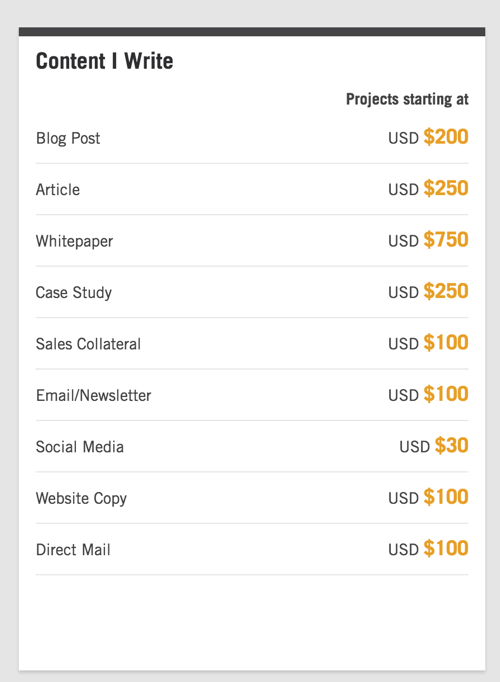Editor’s Note: The following blog, “How to Set Your Freelance Writing Rates,” is part three of a four-part series designed to help freelance writers market themselves more effectively in an increasingly crowded field.
First, you learned how to create a killer bio and resume. Then you learned how to position yourself as an expert. Now it’s time to learn how to ask for — and receive! — the money you deserve.
So what’s the ideal price point for a freelance writer? This is a question that many writers struggle to answer because it depends on several factors.
There are three things to consider when pricing your services:
#1. Industry Standards
There’s a fine line between overpricing yourself, potentially driving away clientele, and under-pricing yourself, and ultimately dismissing your expertise. Understanding what the average industry rate is, and how much someone would need to pay for your specific level of expertise is pivotal to maintaining a successful career as a freelance writer.
#2. Project Scope
It’s important to note the type of content you’re providing a quote for. Is it a blog that’s 500-800 words long, or is it a long-form piece of content closer to 1000 words? How much research does the project require? Does it require technical expertise, or does it cover more basic subject matter?
#3. Your Expertise
As we’ve seen in thousands of instances, brands are willing to put a premium on subject matter expertise. For that reason alone, it’s important to understand your strengths when it comes to topics and not to undersell your experience. Everyone’s an expert in something, so if you’re struggling with this, then look at the writing samples you’ve done and the type of clientele you’ve worked with in the past (learn more about this on our latest blog post).
Within nDash, writers have the ability to set their own rates. You can charge $50 or $5,000 for a blog post. Obviously, the key is to arrive at a number that won’t diminish your expertise and set low expectations but also won’t price you out of the market.
It’s important to note that on your nDash profile, you’re providing a range of prices to give an indication of your rates for different types of deliverables without being too rigid (i.e., “projects starting at”). A few points to note about this rate card:
- You don’t need to charge the same amount for every brand. This just serves as a baseline indicator.
- This is not the lowest rate; it’s the average rate.
- The actual prices you’ll charge will depend on a number of factors, including scope, deadline, and other criteria.

Now it’s time to talk numbers. The ranges below start with what a writer might charge in the beginning, when they have little to no experience writing content, to what the more seasoned writers charge, based on their expertise and portfolio.
- Blog posts (500-800 words): $50 – $500
- Articles (1000 words): $500 – $1500
- Whitepaper / eBook (3000 words): $600 – $5000
- Email / Newsletter (300 words): $30 – 300
- Website Page (500 words): $50 – $500
- Social Post (100 words): $5 – $50
- Case Study (800 words): $50 – $2000
- Press Release (800 words): $100 – $2000
- Sales Collateral (800 words): $100 – $2000
Final Thoughts on Setting Freelance Writing Rates
So which range is right for you? If you’re starting out (less than a year in the freelance writing business), then you’ll likely have to begin at the low end of those ranges.
If you’ve been writing for a year (or haven’t changed your price point in a year), then it’s time to reevaluate and (potentially) bump your rate up. Your freelance writing rates don’t necessarily have to change for your current clients, but you may want to ask more per project going forward from new ones.
Likewise, if you have a Ph.D., and it pertains to the client you’re writing for, you’re going to want to charge a premium for that piece of content because you have the education to back it up.
Yes, pricing yourself can be a bit tricky, but hopefully, this served as a great starting point for either figuring out your rates – or reevaluating why your rates should change.
